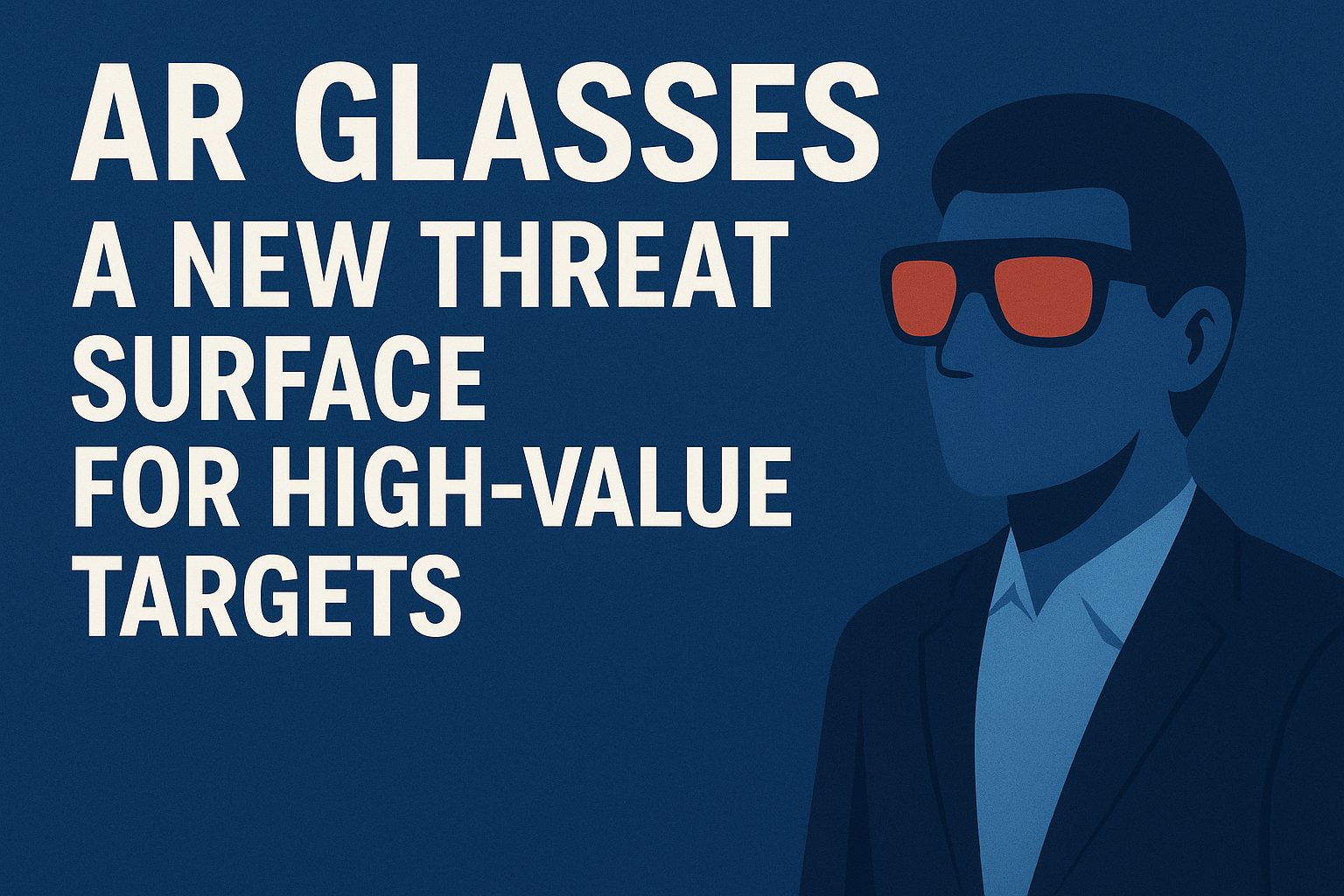AR Glasses: The Surveillance Tool Disguised as Fashion
Augmented reality (AR) glasses are not just eyewear. They’re surveillance tools disguised as fashion accessories. For executives, public figures, and high-value targets, they expand the attack surface in ways few have prepared for.
These devices don’t only capture the world around the wearer. They capture you, your movements, your voice, your habits, your location. That data flows to whoever controls the platform, or whoever manages to compromise it.
Who’s Exploiting AR Glasses
Competitors
Corporate espionage is already on the rise. AR glasses hand rivals a new channel. Imagine a competitor discovering your staff use AR glasses at work. Or worse, gifting “innovative eyewear” under the guise of a partnership. Hidden code or quiet data-sharing agreements can siphon everything from client discussions to private office chatter. Your company culture, your workflows, even the mood inside your team. All become raw intelligence for someone else’s strategy.
Glasses Company Insiders
Tech firms are built on trust. Insiders break that trust all the time. One employee with backend access can track an ex-partner now working at your company, leak data to competitors, or retaliate because of your political positions. You don’t get a say in who at the glasses company touches your data. And once it’s exposed, lawsuits years later are a poor consolation.
Data Wholesalers
Some AR firms aren’t selling glasses at all. They’re selling you. Offering devices at cost or even a loss becomes a customer acquisition strategy for data harvesting. Every conversation your team has while wearing them, every glance, every location, every slip of personal information becomes productized. Without reading opaque terms and conditions, you’d never know what rights you just signed away.
Disgruntled Employees or Customers
Internal threats aren’t always technical. An employee with access to your glasses can pull personal information directly from them if your security protocol is weak. A motivated ex-employee or angry customer could pay someone inside to do the same. For adversaries with technical skill, remote compromises are even simpler: GPS tracking, microphone activation, or malware that turns the device into a permanent sensor trained on you.
Personal Adversaries
Success attracts resentment. People from your past (or even those who still pose as friends) may exploit AR glasses as Trojan horses. A gifted pair of glasses, a borrowed device “for testing,” or a tampered model in your home office can hand them direct access. Few surveillance tools slip so easily into your personal life under the cover of generosity.
Foreign Governments
Executives in advanced tech, defense, finance, or energy already sit in the crosshairs of foreign intelligence services. AR glasses give those services another access point. If the device was built overseas, assume the data pipeline already points back to servers you’ll never see. In sectors critical to U.S. competitiveness, wearing AR glasses is not convenience. It’s a compromise.
What They Extract
What they extract is comprehensive:
- Biological: speech patterns, gait, eye focus, even emotional signals.
Read more in our Biometric Identifier Research (PDF) - Human intelligence: conversations, networks, vulnerabilities.
- Geolocation: your routes, routines, and family movements.
- Corporate intelligence: business strategy, inconsistencies between private and public positions.
Reality Check: The Devices Already Watching You
These aren’t hypothetical threats. AR/AI glasses are already on shelves, collecting data at scale. Some route directly into Meta’s cloud. Others are built in countries where government access is assumed. Here are a few leading devices and the data they harvest:
| Device | Maker | Key Features | Data Collected | Privacy Risks | Default Cloud | Notes |
|---|---|---|---|---|---|---|
| Ray-Ban Meta Glasses (Gen 2) | Meta | 12MP camera, mic, voice assistant, AI photo/video tools | Video, audio, geolocation, biometrics (via voice/behavior) | Data shared with Meta; default opt-in to multimodal AI | Yes. Meta servers | Disabling indicator light already documented in hacks. |
| Xreal Air 2 Pro | Xreal (China) | AR overlays, eye tracking, media streaming | Eye movement, gaze fixation, usage logs | Potential linkage to PRC servers if not fully offline | Likely | Marketed as productivity + gaming device. |
| Vuzix Ultralite | Vuzix | B2B-focused AR, speech input, camera | Video, audio, positional data | Enterprise data capture risk | Yes | Popular in logistics and manufacturing. |
| Rokid Max | Rokid (China) | AR glasses w/ voice assistant, AI assistant | Voice data, gaze, location | Cloud routing overseas likely | Yes | Dual consumer + industrial push. |
| Magic Leap 2 | Magic Leap | AR headset, eye + hand tracking | Eye tracking, gestures, positional mapping | Rich biometric + geolocation | Yes | Used in healthcare, defense sectors. |
| Apple Vision Pro (partial eyewear) | Apple | Eye tracking, facial ID integration | Eye movement, facial patterns | Apple telemetry + iCloud tie-in | Yes | Higher usability, but all Apple ecosystem data flows. |
Should I Use Them?
For high-value targets, the answer is no.
Picture this: you’re in an airport lounge, glasses on, scrolling through emails. To you it feels private. But those glasses are uploading your voice patterns, eye movements, and even which documents hold your attention. A rival or hostile actor doesn’t need to steal your laptop anymore. The glasses have already delivered your cognitive map.
The convenience isn’t worth the leak. For executives, politicians, or public figures, AR glasses aren’t tools. They’re liabilities.
Should I Allow Them in My Organization?
Treat AR glasses like recording devices. Because that’s what they are.
Imagine an investor meeting. Someone walks in wearing stylish Ray-Ban AR frames. No one blinks. They look like normal glasses. Yet they’re quietly capturing every slide, every private comment, every slip of body language. Weeks later, a competitor launches a suspiciously similar strategy.
A “no AR devices” policy should be as standard as “no phones in secure meetings.” Enforce it in boardrooms, strategy sessions, R&D labs, and anywhere sensitive work happens. The cost of one unmonitored device could dwarf years of security investment.
What If People Around Me Are Using Them?
You can’t control every environment. But you can control your response.
In Public Spaces: At a restaurant, someone at the next table has AR glasses. You don’t know if they’re filming, transcribing, or feeding everything to Meta’s cloud. Assume they are. Keep sensitive discussions out of earshot.
At Work Events: You’re at an industry conference. Networking is casual, but competitors are everywhere. Someone asks you a loaded question while wearing glasses you can’t distinguish from normal eyewear. Your answer could be clipped, archived, and reshared out of context.
With Strangers: On the street, a passerby wearing AR glasses looks your way. A scan links your face to broker data, pulling up your home address, family members, or political donations. If your digital footprint isn’t wiped, you’ve just been profiled in real time.
What to do:
- Discipline: Don’t disclose what you wouldn’t want recorded.
- Awareness: Train your team to spot the telltale designs of AR eyewear.
- Mitigation: A simple baseball cap or mask can defeat many facial recognition feeds. But the deeper defense is data removal: if your name isn’t tied to broker databases, a scan doesn’t connect to anything actionable.
ObscureIQ Insight
AR glasses multiply risk across personal, professional, and organizational fronts.
- Don’t wear them.
- Don’t allow them in sensitive spaces.
- Assume everyone else’s glasses are recording you.
The organizations that thrive in this new environment will be those that adapt their behavior now. Before adversaries adapt theirs.




